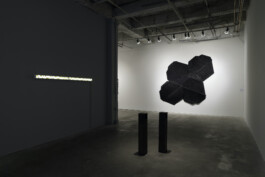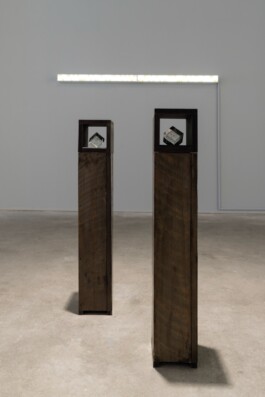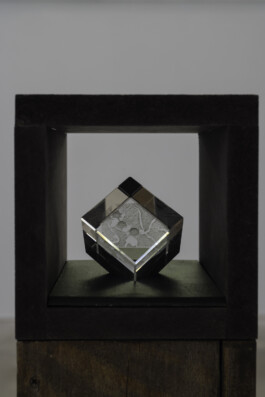Crystal Z Campbell
BEMIS CENTER
Henrietta Lacks forever haunts medicine, which she has irrevocably changed. Following the Black tobacco farmer’s death of cervical cancer in 1951, her immortal cells (HeLa cells) have spread from Baltimore around the world and ventured into outer space. The choice human cell line for biomedical research, HeLa cells have fueled scientific breakthroughs including cloning, gene mapping, in-vitro fertilization, HIV, and the polio vaccine. Until recently, however, Lacks’s vital contribution remained obscured, conveniently folded into four letters—HeLa. And for all but Lacks and her family/descendants, who neither knew why her cells were extracted nor consented to their subsequent uses, HeLa cells have been astronomically rewarding. At the intersection of race, gender, and class, Lacks’s life and afterlives bear witness to the savage capitalist extractivism that sustains America. But Lacks’s legacy—ubiquitous, miraculous, ghostly, and more-than-human—also escapes it, critically fleshing out the fugitive, elaborative work of hospitality.
In Crystal Z Campbell’s Portrait of a Woman I and Portrait of a Woman II, 2013, Lacks’s picture is laser-engraved onto a glass cube; an image of one of her cells graces another. Jewel-like, each effigy is carefully ensconced in a waist-high, dark, and open plinth, requiring that visitors kneel to see them. While relatively low, these twin towers cast long shadows. Nearby, at eye level on the wall, vintage slides of biological specimens sampled around the time of Lacks’s death are presented in a light box. Together, Campbell’s works raise ethical questions about scientific research, the status and uses of biological material, and ultimately life itself.
BIOGRAPHY
Crystal Z Campbell is multidisciplinary artist, experimental filmmaker, and writer of Black, Filipinx, and Chinese descents. A 2021–2022 University at Buffalo Center for Diversity Innovation Distinguished Visiting Scholar and a 2021 Guggenheim Fellow in Fine Arts, Campbell finds complexity in public secrets—fragments of information known by many but undertold or unspoken. Their archive-driven work in film/video, performance, installation, sound, painting, and text has been presented at Drawing Center, New York; Nest, Den Haag, Netherlands; ICA-Philadelphia; Studio Museum of Harlem; SculptureCenter, New York; and SFMOMA, San Francisco; amongst others. Honors and awards include the Pollock-Krasner Award, MAP Fund, MacDowell, Skowhegan, Rijksakademie, Whitney ISP, Franklin Furnace, Tulsa Artist Fellowship, and Flaherty Film Seminar. Campbell was a 2020–2021 Harvard Radcliffe Film Study Center/David & Roberta Logie Fellow and is founder of the virtual programming platform archiveacts.com.
PROGRAMS
Crystal Z Campbell
BEMIS CENTER
Henrietta Lacks forever haunts medicine, which she has irrevocably changed. Following the Black tobacco farmer’s death of cervical cancer in 1951, her immortal cells (HeLa cells) have spread from Baltimore around the world and ventured into outer space. The choice human cell line for biomedical research, HeLa cells have fueled scientific breakthroughs including cloning, gene mapping, in-vitro fertilization, HIV, and the polio vaccine. Until recently, however, Lacks’s vital contribution remained obscured, conveniently folded into four letters—HeLa. And for all but Lacks and her family/descendants, who neither knew why her cells were extracted nor consented to their subsequent uses, HeLa cells have been astronomically rewarding. At the intersection of race, gender, and class, Lacks’s life and afterlives bear witness to the savage capitalist extractivism that sustains America. But Lacks’s legacy—ubiquitous, miraculous, ghostly, and more-than-human—also escapes it, critically fleshing out the fugitive, elaborative work of hospitality.
In Crystal Z Campbell’s Portrait of a Woman I and Portrait of a Woman II, 2013, Lacks’s picture is laser-engraved onto a glass cube; an image of one of her cells graces another. Jewel-like, each effigy is carefully ensconced in a waist-high, dark, and open plinth, requiring that visitors kneel to see them. While relatively low, these twin towers cast long shadows. Nearby, at eye level on the wall, vintage slides of biological specimens sampled around the time of Lacks’s death are presented in a light box. Together, Campbell’s works raise ethical questions about scientific research, the status and uses of biological material, and ultimately life itself.
BIOGRAPHY
Crystal Z Campbell is multidisciplinary artist, experimental filmmaker, and writer of Black, Filipinx, and Chinese descents. A 2021–2022 University at Buffalo Center for Diversity Innovation Distinguished Visiting Scholar and a 2021 Guggenheim Fellow in Fine Arts, Campbell finds complexity in public secrets—fragments of information known by many but undertold or unspoken. Their archive-driven work in film/video, performance, installation, sound, painting, and text has been presented at Drawing Center, New York; Nest, Den Haag, Netherlands; ICA-Philadelphia; Studio Museum of Harlem; SculptureCenter, New York; and SFMOMA, San Francisco; amongst others. Honors and awards include the Pollock-Krasner Award, MAP Fund, MacDowell, Skowhegan, Rijksakademie, Whitney ISP, Franklin Furnace, Tulsa Artist Fellowship, and Flaherty Film Seminar. Campbell was a 2020–2021 Harvard Radcliffe Film Study Center/David & Roberta Logie Fellow and is founder of the virtual programming platform archiveacts.com.







